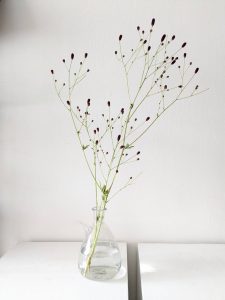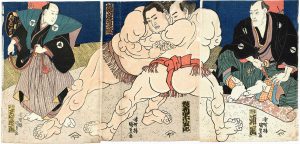その魅力は奥深い・・・(愛知県名古屋市千種区姫池通 骨董買取 古美術風光舎)
2024.09.21
皆さまこんにちは。スタッフTでございます。
店内にワレモコウのお花が顔をのぞかせています。外は真夏のような暑さですが、ワレモコウのおかげで気分だけでも秋を感じられます。

秋というと何となく寂しいイメージですが、スポーツニュースでも寂しいニュースもありました。元大関・貴景勝が現役引退を決断したそうです。なんとまだ28歳1カ月。ご本人の気持ち的にはまだまだと思っても、ケガには勝てなかったということでしょうか。
大関在位30場所は、けがの連続だったそうで、新大関だった2019年夏場所で痛めた右膝に加え、近年は首の痛みに悩まされておられたとか。28歳での早すぎる幕引きとなりましたが、突き押しの威力を追求してつかんだ優勝4度は照ノ富士に次ぐ現役2位。その輝きは色あせないものですね。
1500年の歴史を持つ日本の国技ともいわれている、相撲。髷を携えまわし姿で土俵に立つ超弩級に大きい力士の姿は世界的に有名です。伝統興行でありながら、意外と知られていないような魅力で溢れたものでした。
日本で相撲がおこなわれるようになった歴史は古く、日本書紀や古事記など、日本神話が載っているような古い文献にも、相撲の記述が残されているほどです。古墳から力士を模した人形が出土していることからも、4世紀ごろには既に相撲があったと推測されています。
天皇の前でおこなわれるスポーツの試合を「天覧試合」と呼びますが、相撲の天覧試合がはじめておこなわれたのは4世紀よりも昔、今から2000年も前だといわれています。神話の中の天覧試合では、当時出雲国にいた野見宿禰(のみのすくね)と大和国の当麻蹴速(たいまのけはや)という2人の力自慢が対決しており、キックやパンチも繰り出される取っ組み合いだったとか。
約1500年前に神事として始まった相撲は、江戸時代に入ると庶民の娯楽として親しまれるようになり、やがて「大相撲」という現在に続くプロリーグへと進化していきました。
長く独特な歴史はもちろんですが、ルールや技、格好や所作に到るまですべてが個性的です。「大相撲」の象徴といえば、力士の風貌ですよね。遠くからでも「いる」と分かる力士達の体格は、平均身長183.3cm、平均体重160.5kgと超重量級!大相撲観戦の機会はまだありませんが、この巨体の力士が土俵上で激しくぶつかり合う取り組みは、迫力満点で圧倒されるのでしょうね。

相撲絵(歌川国貞)
相撲ならではの伝統的なアレコレで言えば、土俵を清めるために力士が塩を撒く所作が大好きでした。私が子供の頃は水戸泉が豪快に塩を撒き、館内を沸かせていましたが、今はどうなんでしょう。
その昔、相撲は豊作を願う神事だったことから、土俵は神聖な場所とされ、取り組みの前に邪気を払う「清めの塩」として塩がまかれていました。その伝統が今でも受け継がれているわけですが、「清めの塩」には、あの「伯方の塩」が使われているのだとか。
1場所(15日間)で約520kgの塩がまかれているそうです。単純計算で、1日あたり約35kg、力士1人が約500gまいていることになります。
「伯方の塩」はさらさらした食塩と違い、手の平になじみ、たくさん撒きやすいのだそうで。粒が大きく、土俵に舞う姿も映えると。両国国技館が大きく沸く清めの塩は、実は「伯方の塩」。そう思うと、大相撲になんだか親近感がわいてきますね。
そんな大相撲。今はそれほど見なくなりましたが、実家近くに名古屋場所宿舎があったスタッフTには、子供の頃からわりと身近な存在でした。記憶にはありませんが、遠い昔お相撲さんに抱っこしてもらったそうな。
昔から、強いお相撲さんに赤ん坊が抱っこされると「丈夫に元気に育つ」と言われていますが、ギャン泣きしてきっと本人それどころではなかったと思います…。
ではでは、また。
Hello everyone. This is Staff T.
The flowers of the Japanese snowflake are peeking out in the store. It is as hot as midsummer outside, but thanks to the flowers, I can feel the autumn in my heart.
Autumn is a somewhat dreary time of year, but there was some sad news in the sports news as well. Former ozeki, Takaketsugu, has decided to retire. He is only 28 years and 1 month old. Even though he still feels that he has a long way to go, he was unable to overcome his injuries.
He had been suffering from neck pain in recent years, in addition to a right knee injury sustained in the summer of 2019, when he was a new ozeki. His brilliance will never fade.
Sumo is said to be Japan’s national sport with a history of 1,500 years. The image of a large, oversized sumo wrestler standing in the ring with a topknot in a mawashi (a ceremonial kimono) is famous throughout the world. Although sumo is a traditional sport, it is full of charms that are not well known.
Sumo wrestling has a long history in Japan, and is even mentioned in such old documents as the Chronicles of Japan and the Kojiki, which contain references to Japanese mythology. It is estimated that sumo was already in existence around the 4th century, as dolls resembling sumo wrestlers have been excavated from ancient burial mounds.
A sporting match held in front of the emperor is called a “Tenran-game,” and it is said that the first “Tenran-game” of sumo was held 2,000 years ago, well before the 4th century. In the mythological Tenran match, two sumo wrestlers, Nominosukune from Izumo and Taima-no-Kehaya from Yamato, were said to have fought each other in a duel with kicks and punches.
Sumo began as a Shinto ritual about 1,500 years ago, but by the Edo period (1603-1867), it had become a popular pastime for the common people, and eventually evolved into a professional league called “Ozumo” that continues to this day.
Sumo has a long and unique history, of course, but everything about it is unique, from the rules and techniques to the way it is dressed and conducted. The symbol of “Ozumo” is the appearance of sumo wrestlers. The average height of a sumo wrestler is 183.3 cm, and the average weight is 160.5 kg! I have not yet had the opportunity to watch a sumo match, but I imagine that it must be very powerful and overwhelming to watch these huge wrestlers clash violently with each other in the ring.
Speaking of traditional sumo, I loved the gesture of the rikishi sprinkling salt to purify the ring. When I was a child, Mito Izumi used to sprinkle salt with such gusto that it brought the whole hall to a boil.
In the old days, sumo was a Shinto ritual to pray for a good harvest, and the sumo ring was considered a sacred place where salt was sprinkled as “purifying salt” to ward off evil spirits before each bout. The salt was sprinkled on the ring before each bout as “purifying salt” to ward off evil spirits, a tradition that is still carried on today.
About 520 kg of salt is sprinkled in one place (15 days). Simple calculation shows that about 35 kg of salt is sprinkled per day, or about 500 g per rikishi.
Hakko-no-shio” salt is different from other types of salt in that it is very light and easy to spread on the palm of one’s hand. The grains are large, so they look good dancing in the ring, he said. The salt used to purify the Ryogoku Kokugikan is actually Hakko-no-Salt. When I think about it, I feel a sense of familiarity with sumo.
Such sumo wrestling is not so popular nowadays. Although I don’t watch sumo so much anymore, I was familiar with it since I was a child, as there was a Nagoya Grand Sumo Tournament dormitory near my parents’ house. I don’t remember, but I heard that a long time ago, I was hugged by a sumo wrestler.
It is said that if a baby is carried by a strong sumo wrestler, it will grow up to be strong and healthy.
See you later.
*******************
ご実家の整理やお片付けなどをされている方のご相談などが多くございます。
お片付けなどくれぐれもご無理のないようになさってくださいませ。
風光舎では古美術品や骨董品の他にも絵画や宝石、趣味のお品など様々なジャンルのものを買受しております。
お片付けをされていて、こういうものでもいいのかしらと迷われているものでも、どうぞお気軽にご相談下さいませ。
また風光舎は、出張買取も強化しております。ご近所はもちろん、愛知県内、岐阜県、三重県その他の県へも出張いたします。
なお、毎月21日の持込鑑定会では無料鑑定・買取・ご相談など、ご予約なしで承っております。
ご近所の皆さま、ご遠方のみなさまも、お気軽にお越しくださいませ。
まずは、お電話お待ちしております。
愛知県名古屋市千種区姫池通
骨董 買取【古美術 風光舎 名古屋店】
TEL052(734)8444
10:00-18:00 OPEN
#出張買取#骨董#古美術#骨董品#絵画#版画#茶道具#刀剣#彫刻

